#Jim Capobianco
Photo


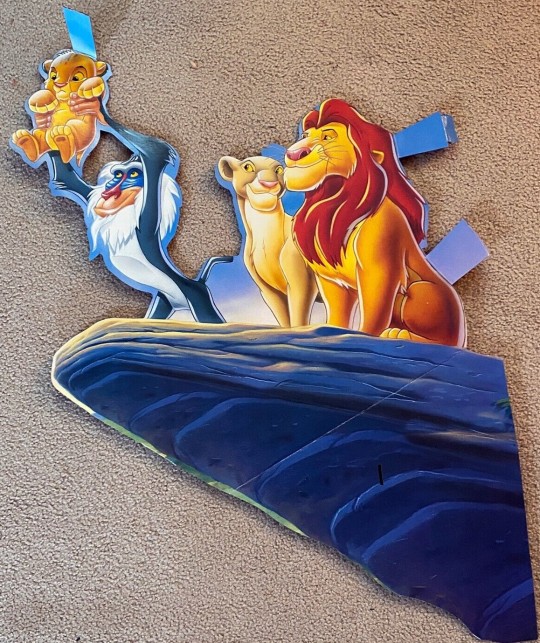


#The Lion King#Disney#Roger Allers#Rob Minkoff#Irene Mecchi#Jonathan Roberts#Linda Woolverton#Burny Mattinson#Barry Johnson#Lorna Cook#Thom Enriquez#Andy Gaskill#Gary Trousdale#Jim Capobianco#Kevin Harkey#Jorgen Klubien#Chris Sanders#Tom Sito#Larry Leker#Joe Ranft#Rick Maki#Ed Gombert#Francis Glebas#Mark Kausler#J.T. Allen#George Scribner#Miguel Tejada Flores#Jenny Tripp#VHS#90s
42 notes
·
View notes
Text

Squideo’s Favourites: WALL·E 🌱
Released in 2008 as Pixar Animation Studio’s ninth feature film, its third since the company was purchased by the Walt Disney Company in 2006, WALL·E had been in the works since the nineties. Created by Andrew Stanton and Pete Docter, this fast classic has become one of Pixar’s standout films. So much so that Disney pushed for an Academy Award Best Picture nomination.
Controversially, this wasn’t accepted by the judges but WALL·E did go on to win their Best Animated Feature prize, and also scooped it up at the BAFTAs, Golden Globes, Hugo Awards, People’s Choice Awards, Saturn Awards, and many more. It even scored two Grammys for Randy Newman and Peter Gabriel’s music performances.
We’re diving into the production behind this animated film, exploring the style and techniques which came together to create this compelling story.
Creating a Story
When Andrew Stanton first came up with the idea for WALL·E, the premise was simple: “what if mankind left Earth and somebody forgot to turn the last robot off?” This was first pitched in 1994 when the young company was thinking about its future films, yet WALL·E wouldn’t start production until 2003 – eventually making it onto screens in 2008.
Stanton continued to develop the idea of a Robinson Crusoe robot with Pete Docter in the nineties, even as both went on to direct other Pixar projects – Finding Nemo (2003) and Monsters, Inc (2001) respectively. There was doubt, however, that this film could be pulled off. Pixar had created anthropomorphised robots before in its first animated short Luxo Jr. (1986). The lamp depicted in this short would become Pixar’s mascot, but was a feature film about a robot something that could be compellingly animated?

What helped to move WALL·E into production was the release of the massively successful Finding Nemo. Like robots, fish weren’t expressive. Like outer space, water was difficult to animate. And yet they pulled it off, releasing what became the highest-grossing animated feature film of all time up to that point and Pixar’s first Academy Award winner. Directed by Stanton, he now had the attention of the company who were eager to hear his next idea.
“WALL-E was a very conscious dive into risk. I knew nobody really wanted to make it. But I also knew nobody could say no to me because Nemo was just so big… we’d been so successful at that point that we could afford the hiccup. If we called it wrong economically or critically, we’d survive it.” Andrew Stanton
The film centred on two robots who only spoke when communicating their names and directives. The majority of WALL·E’s first half is largely free of dialogue, with the exception of live-action recordings from Hello, Dolly! (1969) and Buy n Large’s owner. Many robot characters only converse with chirps and beeps, and the only robot with full lines of dialogue is 2001: A Space Odyssey-inspired villain Auto.
youtube
Key to getting WALL·E into production was the approval of Steve Jobs, who was Pixar’s primary investor and acted as their co-founder and chairman. Jobs split his time at Pixar with Apple where, in 2004, an exciting new product was announced to a select number of people: the development of the first iPhone. The developments at Apple ended up having a profound impact on WALL·E, with the team at Pixar receiving prototype phones before the general public. The film was punctuated throughout with Apple references, using the sound of the Mac boot-up chime when WALL·E finishes charging, and the iPod and iPhone inspiring EVE’s design.
The story is built on themes of environmentalism and global catastrophe, examining consumerism and complacency. One of Pixar and Disney’s most politically themed films, WALL·E attracted conservative criticism but that didn’t stop it from performing at the box office: grossing $532 million worldwide. Receiving widespread acclaim, WALL·E became the second Pixar feature film to be preserved by the National Film Registry and Library of Congress in 2021. In 2022, WALL·E also became Pixar’s first film selected by The Criterion Collection.
Animation Style
While other Pixar films typically generated between 50 and 75,000 storyboards for each production, WALL·E ended up with over 125,000 drawings and 96,000 storyboards. A lot of thought had to go into the character’s design, since their emotions would have to be conveyed physically rather than verbally.
“Robots are a huge challenge, because robots are function-based machines. When you’re drawing them, you can only make up so much stuff that doesn’t actually function, or the person looking at them, even if they’re not engineers themselves, they’re going to notice that that joint wouldn’t actually work. So it became important to look at actual robots. You can only make so much up out of your head.” Jason Dreamer
The team looked at a variety of robots, including those made for bomb disposal. For Jim Reardon, head of story for WALL•E, it was important that they didn’t “draw human-looking robots with arms, legs, heads and eyes, and have them talk. We wanted to take objects that you normally wouldn’t associate with having humanlike characteristics and see what we could get out of them through design and animation.”
To help, Stanton arranged film screenings of classic silent films from the likes of Charlie Chaplin and Buster Keaton to show how silent film actors told stories without reliance on dialogue.
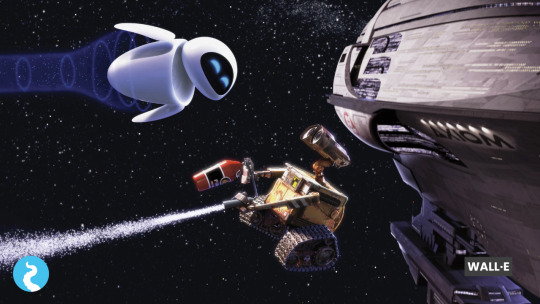
To create the wasteland that WALL·E is left behind in, the animators looked at everything from local dumps to the abandoned city of Chernobyl. For the modern ship Axiom, they looked to Disneyland’s Tomorrowland and cruise ships. To design the human characters, they consulted with physiologist James Hicks to find out the effects of atrophy and prolonged weightlessness while living in space, proving that no detail was too small for the team behind WALL·E.
All of these considerations created a future that seems tangible, and helps to drive the importance of the film’s themes. WALL·E ends on an optimistic note, with Jim Capobianco’s end credits which show the evolution of humanity through different schools of art. For audiences facing the realities of climate change and environmental destruction, this confidence in the power of humanity to fix our world is the right ending. Perhaps explaining why it is one of the few Pixar films to receive no sequel or animated shorts. The story is perfect as it is.
youtube
Get Started With Your Video
Inspired to create a unique animated video of your own? Watch the video below to get a better understanding of how Squideo can help promote your business, then get in touch with us to find out more!
youtube
#wall e#pixar animation studios#disney pixar#pixar#andrew stanton#pete docter#randy newman#peter gabriel#luxo jr#finding nemo#steve jobs#apple#iphone#ipod#criterion collection#jim reardon#jason dreamer#jim capobianco#Youtube
2 notes
·
View notes
Text
"The Inventor"
An adorable (and intellectual) stop-motion animated film that will appeal to adults and kids with a more sophisticated worldview.
“The Inventor” is a very strange animated film. I’m not quite sure the intended target audience for this (it feels very French, so perhaps it’s made for European children with a more sophisticated worldview than your average American kid), because it tackles intellectual things like the Catholic Church’s war on curiosity as well as the toughest question of all: “what is the meaning of life?” One…

View On WordPress
2 notes
·
View notes
Text
Andrew's Review of The Inventor (by Jim Capobianco)
Note: This review was made during the time of the 2023 Writers’ and Actors’ Strike (and finished in November of 2023). Despite not being an official reviewer for a website or publisher, I still stand with the strikers and their attempts to gain better wages and treatments for the work they do. As The Inventor is a film made out of passion, this disclaimer is especially applicable to those who work for something that they love doing. I can only hope for the best that the actors and writers get what they want, and continue to make films like this one under the best circumstances. Learn more at entertainmentcommunity.org
The Inventor
Well, would you look at that, another stop-motion film has come out. I have got to say, when it comes to stop-motion in the 2020s, it has had a good run so far. Whether it be with Aardman producing Shaun the Sheep for Netflix and the Star Wars: Visions short, “I Am Your Mother”, for Disney+, or individual creators like Henry Selick and Guillermo del Toro making animated films like Wendell and Wild and Pinocchio, they have proven to be standouts in their respective years. But this one is not just a regular stop-motion film. This one is the brainchild of Disney and Pixar veteran Jim Capobianco, who has worked as a storyboard trainee on The Lion King, an animation sequence supervisor on Mary Poppins Returns, and, most notably, as one of the writers for Ratatouille, which he got an Oscar nomination for. Back in 2009, he made a short film called "Leonardo,” which was about the life of famous Renaissance artist Leonardo da Vinci, who Capobianco became fascinated with as a person. So much so that in 2018, he started preproduction on an expansion of that short as a feature film that would blend stop-motion with hand-drawn animation! That alone should make this an interesting feature to look at! And with the help of Pierre-Luc Granjon as co-director, Don Hahn as an executive producer, and Cartoon Saloon’s Tomm Moore as a creative consultant, Capobianco has finally released The Inventor to the big screen. That’s right, not to streaming, but to movie theaters. I don’t think there has been a stop-motion film in theaters since Missing Link back in 2019! So now that we will be looking into the life of Leonardo da Vinci, will this film be as grand as his creations, or will it be given the same treatment as Leo was under the Catholic Church? Let’s find out.
The Story
When the film begins, it acknowledges that it is based on the life of Leonardo da Vinci, mainly involving his time at the French court in the 1510s. While some would think that this is a biographical picture of how Leonardo made his creations during that time, that is not really the case. Yes, the story does involve him leaving Italy for the French court, along with his attempts to make an ideal city there. But instead of focusing on ‘the life of the great Leonardo’, The Inventor treats itself as a way of delving into da Vinci’s philosophies and goals through the setting that he is in. As a man in the early 16th century who has a curious mind and craft for creating things, he and his ideas are constantly opposed by those around him, rather it be by the restrictive Catholic Church, or by people who, as Leonardo said it best, “cannot see.” It is due to the struggles that da Vinci faces that the film is able to spread out its messages, or more specifically, Leonardo’s viewpoints. These can range from how people will adapt to machines of war and continue an endless cycle of violence; how a religious group like the Catholic Church can be so dismissive of other views and suggestions that it will act against its intended nature as a group that spreads the love of God; and most notably, how people can see one’s ideas, and how willing they are to accept them. (The scene where Leo tells Princess Marguerite about the three types of people he has encountered: Those who see, those who can be made to see, and those who cannot see, is shown.)
In a way, this could be viewed as commentary on not just the behavior and psychology of people, but also the modern world, since most of today’s recent controversies spring from people who refuse to understand something new or progressive, and will violently deny or fight back against it because it does not match up with their limited views of what should be. But there is another thing that this film addresses, which is Leonardo’s pursuit of what the human soul is. Throughout the feature, Leo constantly tries to figure out what it is all about, and asks some rather deep questions for a family-friendly film. What is the meaning of life? Is there a point to our existence? Why is the soul there, and what is it meant for? And by the end of the film, the answer that is given is one that will probably touch deep with several people. While not a full-on biography, and most likely not a completely accurate one, the story still delves deep into the mindset of Leonardo da Vinci, and the questions and views that he posited.
The Animation
When one hears the words, “from one of the writers of Ratatouille,” they would probably wonder why someone from a CGI-heavy animation studio like Pixar would use stop-motion and hand-drawn animation for this film. Well, as I have mentioned before, Jim Capobianco is already familiar with hand-drawn through his past works, but the most prominent example of his adaptability is the short film that came with the Ratatouille DVD, “Your Friend the Rat.” While Remy and Emile stay their 3D selves, the rest of the short uses a mixture of visual styles, from 2D animation in the style of Ward Kimball’s educational cartoons from the 1950s, to small bits of live-action, pixel art, and, yes, stop-motion. So I think it is safe to say that Jim has plenty of experience to implement those art forms into his own feature.
But getting back to The Inventor, one thing that stands out upon first notice is the designs. When looking at the characters, it is very easy to make comparisons to the Rankin-Bass specials. The heads are rather ovular, their bodies are clearly reminiscent of toy models, and their eyes are merely black dots much like Yukon Cornelius, Santa and Mrs. Claus’ eyes were in Rudolph the Red-Nosed Reindeer. Simple designs, I know, but they are still rather charming to look at, and do have a thematic reason for looking the way they do. Considering how this film is about Leonardo da Vinci, it technically fits in with his work as a tinkerer. Do the characters seem like little figurines, and the buildings and backgrounds around them look like models? Good, because that is basically what Leonardo is doing with his sketches and contraptions. Even when there are a few characters with stand-out details like Leo’s mouth sometimes appearing over his beard, and Pope Leo X having a jaw similar to Burgermeister Meisterburger’s, it is easy to imagine that someone is experimenting with their models to see what else can be done.
As for how the characters move, they do have a good amount of fluidity to them. Not to the extent of Laika’s features, but more so Aardman’s films, where the character animation moves at a good pace, and does follow the anatomy of the human body. And even with the designs being simple, the characters are still able to express their feelings, whether it be through how they move their bodies, or letting the mouth, the eyebrows and whatever else is around the eyes to do the emoting. But I am sure you have all been waiting for me to discuss the film’s standout element, the use of hand-drawn animation.
Throughout the feature, hand-drawn is often used to convey what Leonardo is thinking about, or as a way for a montage or exposition to happen, and It Looks Beautiful. While not changing any of the characters’ designs, the animation does stick close to the artstyle of Leonardo da Vinci, where there are detailed sketches, watercolor and oil paint making up the backgrounds, and even a couple of references to da Vinci’s own artwork. Combine that with some smooth and fluid animation, and having the camera move about to show dynamic angles, and you have got one of the highlights of the picture, especially when Leonardo has one of his soul visions. (Leonardo’s second vision of him trying to reach the female figure is shown.) It is also worth noting that hand-drawn animation does appear within the stop-motion world, and it blends rather well with the full-dimensional figures. Some examples include Leonardo’s thoughts appearing as sketches; the shadowy spies of the Pope slinking about the walls and floors as Literal shadows; and during some of the musical numbers, where the hand-drawn animation both serves as a representation of what the characters want, and interacts with the stop-motion figures most often. (A section from “An Ideal City” where a swarm of people carry away King Francis is shown.) If I were to guess how much which type of animation was used, then I would say it is 65% stop-motion and 35% hand-drawn. And considering how often hand-drawn appears, I think it is safe to say that people will be pleased by the amount that is shown. With some charming stop-motion and a plentiful use of hand-drawn, the animation in The Inventor perfectly replicates the artistic mindset of Leonardo da Vinci.
The Characters
While there are several characters in here who are based on real people, accurately depicting them is not the movie’s main goal. Again, the goal is to spread the message of Leonardo’s mindset. And who better to start off with than Leonardo da Vinci himself. As an artist and philosopher, Leo is fascinated by everything around him, and seeks to find out as much as he can while trying to bring his ideas and observations to life. However, doing so is easier said than done. Along with the restrictiveness of the Catholic Church, he is faced with scrutiny from people whose views do not match with what Leo sees. Even if what he brings up is technologically impressive and could benefit society, they would rather him do as he is told and stick to what is traditionally acceptable. On top of that, Leonardo is already an old man, and will eventually have to move on, so his studies into architecture, machinery, the human soul, and even the dissection of cadavers could be seen as him trying to make an impact before time catches up with him.
As for the other characters, I will admit that there can be those who are mostly there to serve certain roles for the plot, and do not have as much development as Leonardo. But even with that, they still do serve their roles well and can stand on their own. First, there is Francesco Melzi, Leonardo’s apprentice who is the closest confidant and friend the old man has. While Melzi is mainly an assistant who is there for da Vinci to talk to, he is still loyal to the old man and helps him out with his experiments, while also trying to remind him of how he should not get into trouble with the people up top. Alongside the apprentice is Zoroastro, the silent heavy muscle who helps Leonardo with construction and retrieving cadavers. Then there is King Francis I, the King of France who invites Leonardo into his court after witnessing one of his inventions. However, while his interest in Leonardo is genuine, it only goes so far, since he wants the artist to make statues of himself to show off to the other kings. And with his blustery attitude adding to his shortsightedness, this often leads to his mother, Louise of Savoy, to be the one to take charge of the situation and determine what is best.
And then there are two characters who stand out above the rest. The first of the two is Princess Marguerite de Navarre. Out of all the characters, she is the one whose role and development is able to stand toe-to-toe with Leonardo’s. Unlike her brother Francis, Marguerite is more in touch with the civilians of her kingdom, and prioritizes giving them comfort. This mindset draws her towards Leonardo, whose concepts for an ideal city and queries into the universe give her someone she can view and confide in as an equal, while also giving the inventor someone in the upper class to share and teach his ideas to who can hopefully make things go for the better.
And the other character is Pope Leo X. While only present in the beginning of the film and the end of the second act, his scenes alone are one of the film’s highlights. As the head of the Catholic Church, he is portrayed as a grown man with a childlike attitude, often giving out fiery statements of what is right and wrong, stating one thing in the moment only to hypocritically state another the next minute, and being swayed by whoever is near him. And with him sending out spies to observe what Leonardo is doing, along with being a bit gung-ho for confronting people, he shows how a religious group that is meant to spread the teachings of God and His love can Easily turn into an oppressive regime that is more focused on maintaining a status quo that barely resembles the group’s original intentions. And considering my comments sound like critiques against a major system of power, I’m probably next on the Pope’s chopping block after Leonardo. (A clip is shown of Francesco telling Leonardo his ideas will “get him into trouble.” The Pope: “BLAS-PHE-MYYYYYY!!!!!” Francesco: “Like, dead trouble.”)
I would also like to point out that the actors did a good job bringing their characters to life, while also adding to their personalities. These include Stephen Fry’s inquisitive warmth in Leonardo; Daisy Ridley’s curious wonder in Marguerite; Marion Cotillard’s strict and regal tone for Louise of Savoy; and Matt Berry giving out a pompous performance befitting Pope Leo X. Alongside some nice voice acting, the characters come together to show what it is that Leonardo seeks, and can even leave a bit of an impact on the viewer.
The Songs
Yes, much like Guillermo del Toro’s Pinocchio, this is another stop-motion animated film with songs in it. However, I wouldn’t exactly categorize these as ‘musical numbers’ per say. They instead serve a similar role to the songs in Pinocchio, where, instead of being big, lavish song-and-dance numbers, they are meant to either help show the characters’ wants and states of mind, or progress the story, often through montages.
The first song of the movie is “The Shepherd’s Song,” which is more of a hymn or sermon that Pope Leo gives to Leonardo, while indirectly describing how he spreads the religious teachings of the Catholic Church. (“The shepherd leads the way / Sheep go about their day / They grow their wool, they breed, and then they die”) Following afterwards is “Mona Lisa,” a brief lament from Leonardo on his situation in Rome and how he may have to stop his studies. (“What counsel can you give me? / Have we really reached the end?” / “We’re out of time, we’re out of time / There’s nowhere left to go”) Then there is “Leonardo’s New Home,” a jaunty little song that also counts as the first ‘montage’ song, accompanying da Vinci as he prepares to bring his ideas to France. (“This will be the perfect library / A study beyond compare! / I could openly look at any book / The Pope need not know nor care”) After a while is “From This Tiny Seed,” sung by Princess Marguerite as she starts to work with da Vinci on the ideal city and what she wants from it. (“Each fulfills their role / Each part forms a whole / Our community / Exists in harmony”)
Then the next song is “An Ideal City,” where da Vinci and Marguerite present the planned ideal city and how it will work. (“Humans and garlands / With God’s creation / To all the world / An inspiration / That’s what’s in store / For our ideal city / And what’s more / It’s charming and pretty”) After that is “Kings!,” heralding the arrival of the other European kings. Out of all the songs here, this is the one that would fit the most into a Rankin-Bass special, since it is a more fun song that acts like an event rather than a part of the plot. Think of it as the equivalent to “Fourth of July Parade” from Rudolph’s Shiny New Year. (“On your knees / Pay tribute to your kings / About to meet / [Can’t quite discern what is said here. Sorry] simple little things”) Following afterwards is a combined reprise of “Mona Lisa” and “From This Tiny Seed,” but since that one contains some spoilers, all I will say is that it shows Leonardo rising from his lowest moment. So let’s move on to “En Garde, Pret, Allez!”, which is another ‘montage’ song sung by Louise of Savoy while she helps King Francis entertain the other kings. (“En Garde, Pret, Allez / First you’re winning / Then your plans all go astray / When the world makes you feel dizzy / Don’t go into a tizzy / Turn your spinning into a ballet”) And finally, there is “Song of the Stars,” which acts like the final thesis statement of the film. (“See things unseen / Behind the screen / Ever beyond our reach”)
I will admit, by the time I started making this review, I was having a bit of trouble remembering how the songs went, since some of their melodies can blend together if you’re not paying attention, and their status as ‘slower-paced, non-Broadway songs’ prevents them from being as catchy as a song from Disney. But after taking the time to listen to them individually, I can say that they are rather good. Along with having some nice lyrics and music conducted by Alex Mandel, each of the songs do have their place in the story. Again, they are primarily meant to help establish what the characters think and want, and they do a good job of conveying the hopes and ideas that Leonardo and Marguerite have. Even the montage songs are entertaining in their own right, since they have the animation help show what the characters are trying to do to achieve their goals. The songs in this movie may not be one of the main spectacles on display, but they are still an essential part, and can bring their own value to the picture.
There have been several big events in theaters this year, but this film is easily up there as one of my top experiences. The Inventor is an amazing film that serves as a celebration of Leonardo da Vinci. The story is simple, yet contains some deep themes and questions; the animation is beautiful and pays tribute to what came before, whether it be the stop-motion Rankin-Bass specials or da Vinci’s hand-drawn sketches; the characters have some nice acting while also being capable of leaving a huge presence; and the songs, while not grand, do help accentuate the characters’ wants, and the themes of the film. If you are a fan of stop-motion, hand-drawn, art, or are interested in Leonardo da Vinci and his creations, this is a must-watch! In fact, I can see this being shown in art classes for kids to watch, even if some of the subject matter may fly over their heads. And while, yes, this was not shown much in theaters and is currently out of them, The Inventor is now available on demand and online, so I would still recommend giving it a watch. I would also suggest sticking through the credits. Not only will you find a few fun Easter eggs in them, but you will also get a look at the behind-the-scenes process of the picture, and have a deeper appreciation for the people who helped bring it to life, either through directly working on it, or just through the Kickstarter campaign. This may not have been as hugely promoted as Mario or any other blockbuster in 2023, but The Inventor is on the same level of quality as Elemental, Nimona, and Across the Spider-Verse, and will be one of my personal favorite films I have watched this year.
Story: 10/10. Animation: 10/10. Characters: 9/10. Songs: 8 or 9/10. Overall Rating: 9/10.
Dingle, Jon. “Interview: Jim Capobianco Chats ‘Ratatouille’, ‘The Lion King’ and ‘The Inventor’.” Filmoria, 15 May 2018, https://www.filmoria.co.uk/interview-jim-capobianco-chats-ratatouille-the-lion-king-and-the-inventor/.
#review#the inventor#animation#stop motion#hand drawn#leonardo da vinci#stephen fry#daisy ridley#matt berry#marion cotillard#Jim Capobianco
1 note
·
View note
Text
The Inventor 2023 Movie Review!
The Inventor (2023) is a stop-motion animated film about Leonardo da Vinci, the Italian polymath who is widely considered to be one of the greatest geniuses of all time. The film follows Leonardo as he travels to France to work for King Francis I, where he continues to pursue his wide range of interests, including painting, sculpture, architecture, engineering, and anatomy.
The film is directed…
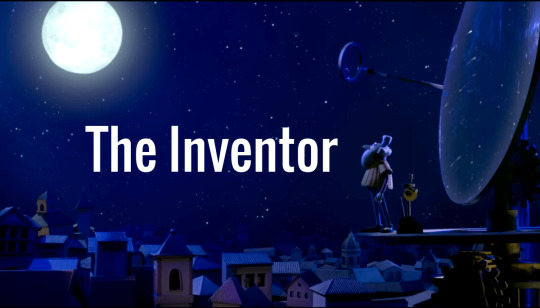
View On WordPress
0 notes
Text
2D Purists, Cut It Out

Once again, I'm seeing people get all ornery over the latest look at WISH, the new feature from Walt Disney Animation Studios that marries their post-TANGLED house style and aesthetic to a more watercolor-based look. Once again, people are grousing that it doesn't look as good as the 2012 short PAPERMAN, and others are grousing that it just isn't 2D, period. I feel like the artists and film crew behind WISH are getting a lot of flack, especially on the heels of the recent Writer's Strike coming to an end. Not a good look, if you ask me.
I've gone over it many times before, I'm farggin' exhausted. Walt Disney Animation Studios, as they stand, are likely lucky to even be making films, let alone make it to 100 years of existence. It's the bedrock of the entire company: No Disney Brothers Cartoon Studio, no Walt Disney Company. It seems as if it's alive by virtue of that alone... They were on the chopping block multiple times in the post-Walt span of 67 years, as recent as 2006, believe it or not! Each movie has to do well in some way in order to justify to the heads that they're a building worth investing hundreds of millions of $$$ into. When reliable hitmaker Pixar is right next door, too. Remember, Disney purged a long list of animation studios/partners: Blue Sky Studios, Disneytoon Studios, several arms of the animation studio, Skellington Productions, etc. etc. So, I'm just going to take what I can get. I'm sure I'll find something of merit, both visually and storytelling-wise, in WISH. The recent trailer, I thought, was a bit of alright. Nothing too fancy to me, but it looks like it'll be a fun time nonetheless. I haven't been wowed upside-and-down by a WDAS feature in ages, but that's a me thing. WDAS is doing THEIR thing, and I guess it's not entirely for me. That's OK! Clearly it's working on someone else... Note ENCANTO, RAYA, and even STRANGE WORLD's sheer success as streaming titles, ditto slightly older movies like the FROZENs and MOANA.
But I think some people should understand that in animation, on one half of the playing field, it's not about the art unfortunately. It's called the animation INDUSTRY for a reason.
I get it. We miss the halcyon days of Disney making a new, gorgeous, splendorifously animated feature using pencil and paper, and post-1989, a lot of digital aid. I get that. I'm a 1992 baby, that era was my era, my jam. THE LION KING alone is one of my **formative** films. It's why I write stories and make comics and would LOOOOVE to turn them into animated movies. I was a preteen during the BROTHER BEAR/HOME ON THE RANGE days when it was all fading away, and I watched - as a late teen/young adult - the studio try to make it a thing again, only to blow it.
It's because it was never about the method, the technique, or anything.
To the artists and filmmakers, it absolutely was! No denying that.
To the bean counters? NO. It's product to them, builds the bottom line, fills the pockets, etc.
That's how it's been in the post-Walt age, post-Golden Age, whatever. Steve Hulett, who worked at Disney Animation circa 1976-86, summed it up once: "These are studios. Not Renaissance art factories."
It makes me think of how a lot of classical art was commissioned by merchants, it was largely glorified fanart of Biblical scenes, but the artists who made those works put their ALL into them. Much in the same way the filmmakers put their all into [name any Disney/big studio 2D animated movie made from 1990 to 2004].
In order words, they more than understood the assignment, no matter how flawed the picture might've been on a writing level. (Like say, POCAHONTAS, an utterly gorgeous movie that the filmmakers clearly went HARD during its production.)
There are so many 2D movies made around the world or independently. I recently saw Disney and Pixar veteran Jim Capobianco's THE INVENTOR, a half Rankin/Bass-style stop-motion half European-like 2D film, in a theater! All by myself, may I add. 10 years in the making, a personal labor of love of his own.
Are these complainers *ever* there for those types of films? I thought so.
Where am I going with this? Ah yeah, that's a big reason why 2D was shuffled out of the question by executives. CGI was huge in the early 2000s, and it seemed that even the least-liked features (note SHARK TALE and CHICKEN LITTLE's critical reception) could outgross or out-success the most beloved 2D features of that period. Both of those movies outgrossed LILO & STITCH, for context...
Now, couple that with CGI being less of a hassle in certain ways. Suppose a big change is made to a movie well into production, and scenes have already been animated. Shaded and lit, even. Well, the sets and character models are still there, so the worst they have to do is shoot a scene from a different angle and reanimate their digital puppets. In 2D? New background to draw and paint, gotta redraw and reanimate the characters AGAIN and keep them ON MODEL- ahhhhh! You can see why CG is preferred in this instance. Perfect for a pipeline of movies that can't be disrupted.
So to bean counters and execs, it was only about getting movies made and them making money. In the early 1990s, CG wasn't at a place where it could sustain a feature-length film, so big-time animated movies were done in 2D almost exclusively. And it just so happens... The animators at studios like Disney, like DreamWorks, like Fox Animation, like Kroyer Films, like Warner Animation, etc... The makers of all your faves from HUNCHBACK OF NOTRE DAME to THE IRON GIANT to THE ROAD TO EL DORADO to ATLANTIS, etc. The filmmakers got the assignment. That assignment being "Make big family film that's sure to be big franchise and McDonald's Happy Meal hit". They took that assignment, and WENT HARD. They didn't have to, but they did anyways. They gave us the coolest damn 2D animation we could've asked for, no matter the writing or the finished movie and how it would fare with critics/audiences. And even the writing, it's like, they did what they felt was right - even if it didn't register for critics nor get audiences interested.
So, again, it was all assignments, and 2D was pretty much the only method they could use. Stop-motion was reserved for the likes of NIGHTMARE BEFORE CHRISTMAS and CHICKEN RUN, more off-beat projects. There was never a stop-mo wave. LAIKA literally runs off of commercials and shoe money, the exploits of a nepo baby. So, it was mainly 2D til TOY STORY came along. TOY STORY came out in fall 1995, and once you started seeing films like ANTZ, A BUG'S LIFE, TOY STORY 2, SHREK, etc. That was it. And these developments coincided with audiences choosing the 2D animated movies they wanted to see, and avoiding the rest... And also them getting so wowed by CGI, while seeing 2D as same-old same-old. Capitalism then cemented 2D features' fate, unless it's based on a TV show, like SPONGEBOB or MY LITTLE PONY. It didn't matter that the CGI wow factor was a fad, and that by the end of the 2000s, audiences didn't flock to see *every* CG movie on the block. CGI was the way, and that was that about that. Because it's about getting the thing made and released without the special challenges a 2D movie presents.
Only FIXED is the anomaly right now, which Sony Animation was willing to take a chance on. It is still unknown if it hits theaters or streaming. If it's the former, this is... I think the first 2D animated **theatrical** movie from a mainstream animation studio that's *not* based on a TV show in ages. Like, since... What? WINNIE THE POOH? (Which is based more on the classic Disney shorts/feature than any of the TV show iterations of the character.) THE PRINCESS AND THE FROG?
You can never guess what audiences will flock to see. If you randomly threw a solid 2D feature out in, say, 2027... It could be big, it could flop hard. But the studios, the industry, they're unwilling to chance that. Thus they aren't, and will not. Quality doesn't matter, because you could throw a **great** 2D movie out, and it could still flop just because... If FIXED does well, I don't know what it means. Could move a needle, maybe not. I kinda don't care, because capitalism is an unmovable object. I don't have a crystal ball, and I can't say for sure what could happen. I guess you could say I'm "Will 2D Come Back" Agnostic. I don't deny it, but I don't think it'll for sure happen. I DO NOT KNOW, haha.
The mass refusal to make 2D animated features in mainstream theatrical feature animation (not streaming, mind you, as we did get KLAUS, WOLFWALKERS, and MY FATHER'S DRAGON from some of the high-end services) was so firm, so absolute, that the idea of traditional animation might as well been tax write-off'ed and Men In Black-erased from our minds. That's how FIRM these companies were in getting rid of it, that's how FIRM they are in NOT wanting to utilize it for a feature film.
So instead, we get stylized CG films like the SPIDER-VERSEs and PUSS IN BOOTS 2 and MITCHELLS VS. THE MACHINES and NIMONA and such. We get maybe a brief 2D scene in a larger CG movie, or some small 2D elements. That mix has got the advantages and the 3D immersiveness of CGI, mixed with that special sauce people love about 2D... And even then, for some people, it just isn't enough. Some will insult the artists and their work, which is not cool. But I'm sorry, either take what you can get or continue to be unsatisfied... Or, seek out 2D stuff that's regularly being made. That's just not by studios as big as Disney and DreamWorks, and not being made in America at that. Broaden your horizons, they're EVERYWHERE.
Anyways, had to vent. Sorry. WISH looks cool, will be seeing.
7 notes
·
View notes
Photo

EXPOSITION | Coulisses du film d’animation Léo, la fabuleuse histoire de Léonard de Vinci ➽ https://bit.ly/Exposition-Film-Leo Au Clos Lucé, une exposition révèle les coulisses de la dernière réalisation en stop motion du scénariste de Ratatouille, Jim Capobianco
#exposition#coulisses#film#animation#stopmotion#Léo#LéonardDeVinci#château#ClosLucé#scénariste#Capobianco
2 notes
·
View notes
Text

The Inventor: Directed by Jim Capobianco, Pierre-Luc Granjon. With Daisy Ridley, Marion Cotillard, Matt Berry, Stephen Fry. Inventing flying contraptions, war machines and studying cadavers, Leonardo da Vinci tackles the meaning of life itself with the help of French princess Marguerite de Nevarre.
3 notes
·
View notes
Text
10 years a LEFTY
After my stroke at the end of 2012, my focus for most of 2013 was on learning how to walk & talk again, and navigating the bureaucracy of disability benefits. By September, I was still very much a mess, but finally wrestled with an issue that had weighed heavily on me the entire time - whether I’d ever draw again.
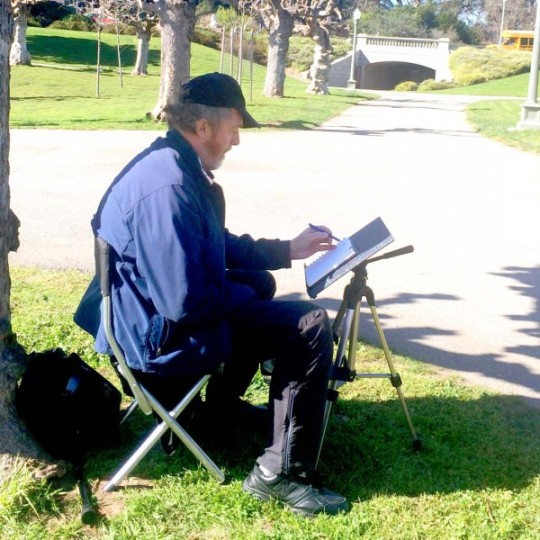
Sketching in Golden Gate Park.
Janine Dawson had sent me a sketchbook while I was still in hospital, complete with pre-dated pages. I could not keep to her schedule though. Partly because I had so much physical therapy and became exhausted easily. Also, I was deeply afraid. My clumsy attempts to draw with either hand caused despair. So I focussed instead on the many other things I needed to do. There’d been hope that sensation & motor coordination might return to my right drawing hand eventually, but 9 months later it was still asleep (and in most respects, still is). I finally accepted that my trusty right hand was kaput, and wouldn't draw again. It was a bitter pill to swallow, but only after that acceptance could I train the understudy to go on stage - My LEFT HAND.

A self-caricature in my wheelchair, 2013.
I drew for its own sake, with absolutely no expectation of ever drawing professionally again. That filled me with sadness, but the idea that I might not draw at all was worse. Drawing was always part of my self-identity. So, Julia & I often drew together. I was painfully slow, but started to enjoy the random quality of my drawings done with my non-dominant hand. Never exactly sure what my LEFT hand would do, I drew in a spirit of exploration, like when I was a child. (I now believe that this open lack of expectations actually set me free). My mobility was even worse than it is now and we often drew paused images from TV, but went location sketching too, starting at the college campus near our apartment.
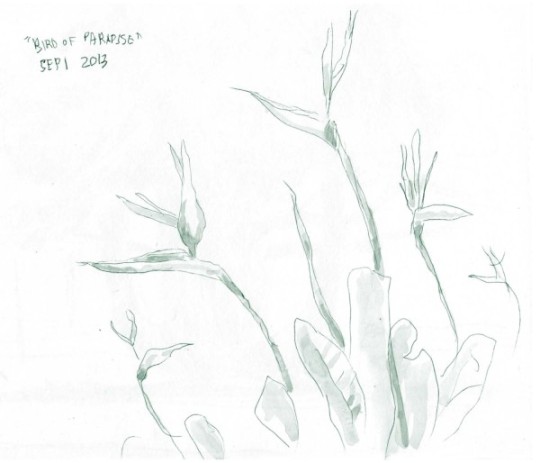
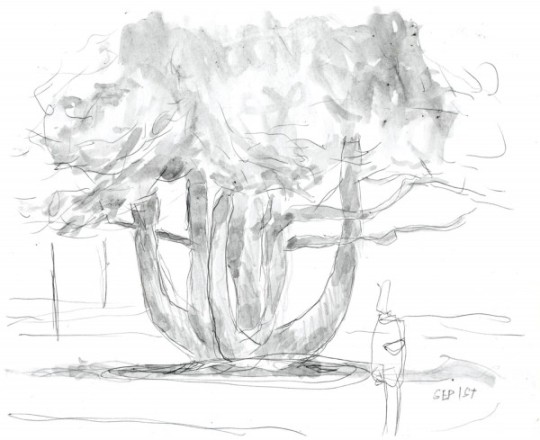
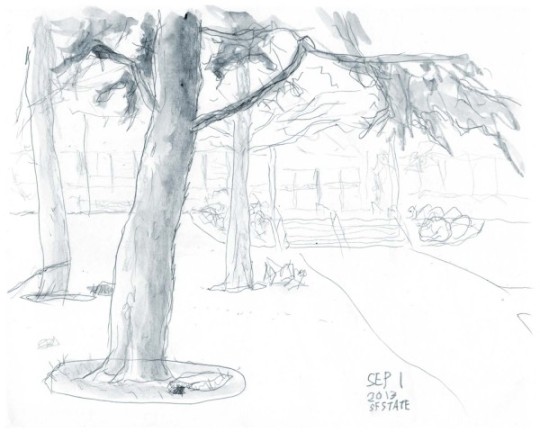
Sketches of SF State campus, 2013.
Julia had bought me two beautiful leather bound sketchbooks for Christmas 2012 (and I had a stroke the very next day). 2014 was when my drawing had progressed enough to start filling one of them with sketches. I went out sketching with her, or sketchmaster Matt Jones. Unsure of how to earn a living, I often considered what other job I might do.. Be a writer? A teacher? Kevin Richardson helped me explore script writing. Steve Purcell & Derek Thompson called me for a few weeks of story brainstorming. It is hard to overstate how much those first short gigs meant to me. I began to feel useful again. In the first year of my stroke many friends (from many studios) had arranged fundraisers to help with my medical bills, but I was too frail to attend. In 2014, Ben Walker arranged “Bizarro Sketch Night”, where artist friends bid on each other's art, drawn with their non-dominant hands. A fun event that I was able to participate in myself. I'll never forget all these encouragements from my community.

"Bizarro Sketch Night", 2014.
John Hoffman gave me a sketchbook, and in 2015 it was where I began to sketch out a graphic novel. The plan is to incorporate old pages done with my RIGHT hand and new pages done with my LEFT, and for them to be compatible (this art-therapy project continues to this day). Julia encouraged me to start colouring my blog stories digitally (and for Christmas that year, she bought me a new cintiq!) Using Photoshop with one hand was tricky, but the workarounds I learned came in handy when I got my first ever LEFT-handed paid drawing assignment, a cover for Carol Hughes’ book!
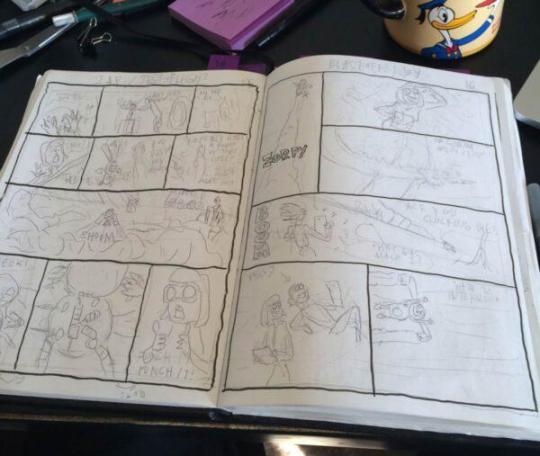
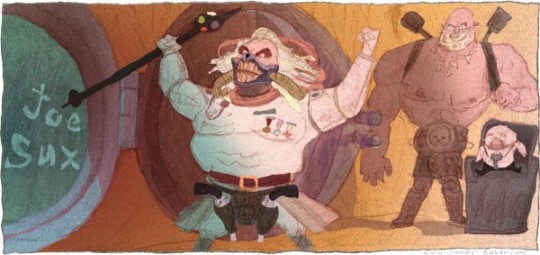
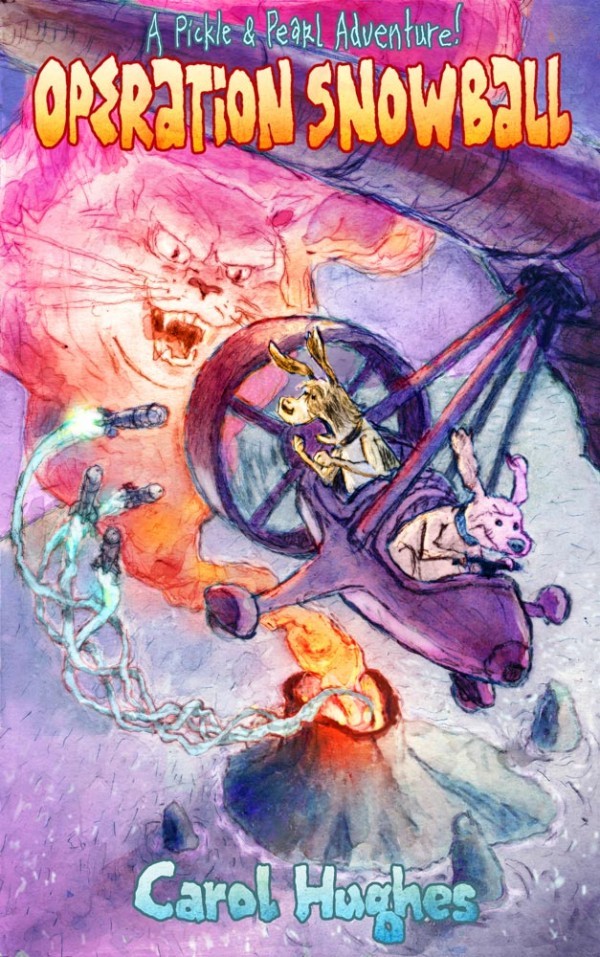
2015 projects.
2016 had so many work opportunities that I was taken off disability. My financial safety net was gone, but it was exciting to take the plunge into freelancing as a LEFT handed artist. Again, friends gave me encouragement & chances. Steve Lee got me a brief teaching assignment (at the Academy Of Art). Then Jim Capobianco asked me to storyboard on "MARY POPPINS RETURNS". This was very exciting development for me. It was a long gig, subletting a room in one of the satellite buildings of PIXAR's Emeryville campus, where old colleagues were watching my progress..

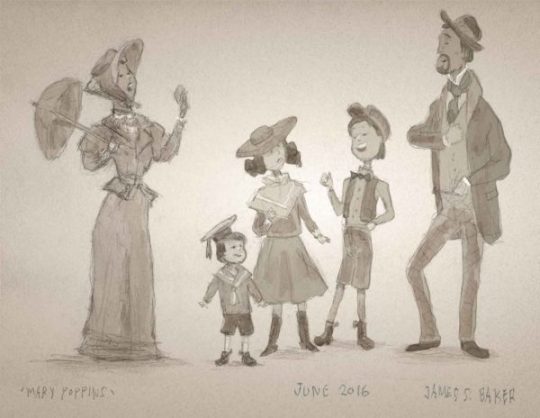

"Mary Poppins Returns", 2016.
In 2017, I did LEFTY storyboards for Brad Rau at GHOSTBOT. Soon after,Jonas Rivera suggested I try out storyboarding on a PIXAR project, which became Pete Docter’s "SOUL", and after a few months, that became a staff position. It was wonderful to be working again with my old roomie Rej Bourdages, who’d always supported me in my darkest hours. Keeping up with all the other inspiring drawing geniuses in Emeryville is intimidating for a one-armed old duffer, but is a great way to improve. In 2018 & 2019 my drawing dexterity & speed increased (and with this steady job, I finally paid off my mountain of medical debt). The 2020-2022 pandemic years were ironically a boon. Working from home gave me extra hours (previously sucked-up by my commute) to do more spare time personal projects, where I pushed my LEFTY drawing skills even further.
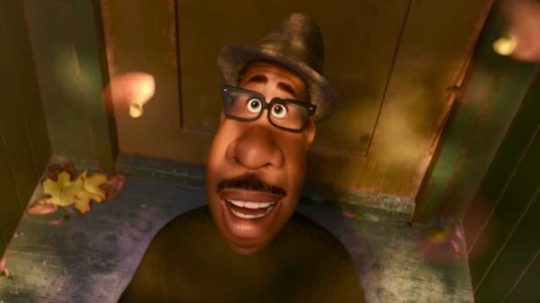
"SOUL"
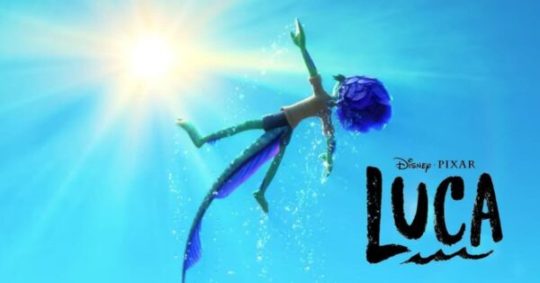
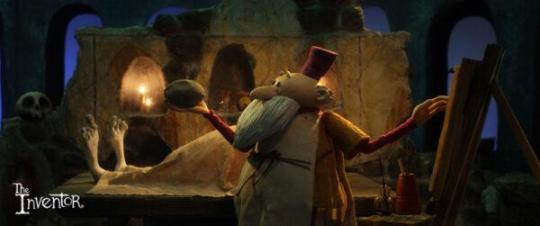
"the INVENTOR"

"ELiO"
Animated films worked on since 2017.
It’s been a decade since I began drawing with my non-dominant hand. Every day is still a struggle, but I'm so grateful to be where I am now. On this day in 2013, I had absolutely no hope that I'd ever become a full-time professional cartoonist again. That I actually got here is due to many colleagues, friends & loved ones not only encouraging me to draw, but giving me real professional opportunities to do so.
All throughout this topsy turvy journey, at every low & highpoint, Julia has never lost faith in me. Even though I became a feeble old man overnight, she stayed with me. She understands how important drawing is to me (as it is to her too) and she has always offered encouragement. She has gone out drawing with me. Challenged me, and pushed me to new levels. Her artistry is a constant inspiration. I'm extremely lucky to have her by my side.
I'm profoundly grateful to all of you, who've supported me in so many ways over the past 10 years. You've given me great joy.
Thank you!
#cartoons#drawing#my stroke#left handedness#artists on tumblr#brain stroke#strokerecovery#animation#animators on tumblr
2 notes
·
View notes
Text
Star-Studded Stop-Motion Musical ‘The Inventor’ Gets Official Trailer Ahead Of August 25 Theatrical Debut
'Ratatouille' scribe Jim Capobianco makes his feature directorial debut with 'The Inventor,' which screen in the main competition at Annecy.
from Cartoon Brew https://ift.tt/Aq6GYZ4
2 notes
·
View notes
Text
Movie Review: The Inventor (2023)
Title: The Inventor
Release Date: 15 September 2023
Director: Jim Capobianco
Production Company: Curiosity Studio | Foliascope | Leo & King
Summary/Review:
The Inventor depicts the final years in the life of Leonardo da Vinci (Stephen Fry). All he wants to do is dissect cadavers to learn about the human soul, but Pope Leo X (Matt Berry) is cramping his style. So he joins the court of Francis I…

View On WordPress
1 note
·
View note
Photo
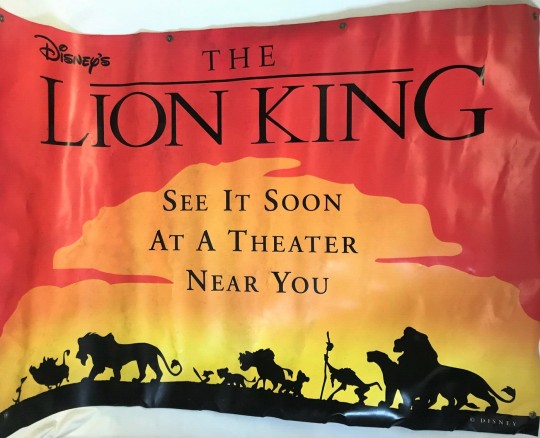
#The Lion King 1994#The Lion King#Disney#Roger Allers#Rob Minkoff#Irene Mecchi#Jonathan Roberts#Linda Woolverton#Burny Mattinson#Barry Johnson#Lorna Cook#Thom Enriquez#Andy Gaskill#Gary Trousdale#Jim Capobianco#Kevin Harkey#Jorgen Klubien#Chris Sanders#Tom Sito#Larry Leker#Joe Ranft#Rick Maki#Ed Gombert#Francis Glebas#Mark Kausler#J.T. Allen#George Scribner#Miguel Tejada Flores#Jenny Tripp#Bob Tzudiker
44 notes
·
View notes
Link
0 notes
Text
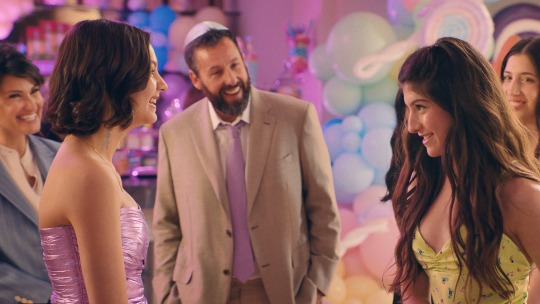
Friday Releases for August 25
Friday is the busiest day of the week for new releases, so we've decided to collect them all in one place. Friday Releases for August 25 include You Are So Not Invited To My Bat Mitzvah, ARMORED CORE VI FIRES OF RUBICON, another triumph of ghetto engineering, and more.
You Are So Not Invited To My Bat Mitzvah
You Are So Not Invited To My Bat Mitzvah, the new movie from Sammi Cohen, is out today.
Stacy and Lydia are BFFs who’ve always dreamed about having epic bat mitzvahs. But things start to go comically awry when a popular boy and middle school drama threatens their friendship and their rite of passage.
Bottoms
Bottoms, the new movie from Emma Seligman, is out today.
want to get punched in the face by hot girls? WELL GET IN LINE.
Retribution
Retribution, the new movie from Nimród Antal, is out today.
When a mysterious caller puts a bomb under his car seat, Matt Turner (Neeson) begins a high-speed chase across the city to complete a specific series of tasks. With his kids trapped in the back seat and a bomb that will explode if they get out of the car, a normal commute becomes a twisted game of life or death as Matt follows the stranger’s increasingly dangerous instructions in a race against time to save his family.
Bank of Dave
Bank of Dave, the new movie from Chris Foggin, is out today.
Based on the true-life experiences of Dave Fishwick; ’Bank of Dave’ tells the story of how a working class Burnley man and self-made millionaire fought to set up a community Bank.
Scrapper
Scrapper, the new movie from Charlotte Regan, is out today.
This vibrant and inventive father-daughter comedy follows Georgie (Lola Campbell), a resourceful 12-year-old girl who secretly lives alone in her flat in a working class suburb of London following the death of her mother. She makes money stealing bikes with her best friend Ali (Alin Uzun) and keeps the social workers off her back by pretending to live with an uncle. Out of nowhere, her estranged father Jason (Harris Dickinson; Triangle of Sadness, Beach Rats) arrives and forces her to confront reality. Uninterested in this sudden new parental figure, Georgie is stubbornly resistant to his efforts. As they adjust to their new circumstances, Georgie and Jason find that they both still have a lot of growing up to do.
The Dive
The Dive, the new movie from Maximilian Erlenwein, is out today.
A dive at one of the world’s most remote spots becomes a fight to the death for sisters Drew (Lowe) And May (Krause) when a landslide sends rocks tumbling into the sea, trapping May in the depths. As their oxygen runs low, Drew must make life-and-death decisions with no outside help in sight…
The Retirement Plan
The Retirement Plan, the new movie from Tim Brown, is out today.
In The Retirement Plan, when Ashley (Ashley Greene) and her young daughter Sarah (Thalia Campbell) get caught up in a criminal enterprise that puts their lives at risk, she turns to the only person who can help - her estranged father Matt (Nicolas Cage), currently living the life of a retired beach bum in the Cayman Islands.
Piaffe
Piaffe, the new movie from Ann Oren, is out today.
Introverted and unqualified, Eva is unexpectedly tasked with foleying the sound for a commercial featuring a horse. As she slowly acclimates to the new job, her obsession with creating the perfect equine sounds grows into something more tangible. Eva harnesses this new physicality, becoming more confident and empowered, and lures an unassuming botanist into an intriguing game of submission.
The Inventor
The Inventor, the new movie from Jim Capobianco and Pierre-Luc Granjon, is out today.
The insatiably curious and headstrong inventor Leonardo da Vinci leaves Italy to join the French court, where he can experiment freely, inventing flying contraptions, incredible machines, and study the human body. There, joined in his adventure by the audacious princess Marguerite, Leonardo will uncover the answer to the ultimate question – “What is the meaning of it all?”
ARMORED CORE VI FIRES OF RUBICON
ARMORED CORE VI FIRES OF RUBICON, the new game from FromSoftware and Bandai Namco Entertainment, is out today.
In ARMORED CORE VI FIRES OF RUBICON, players will assemble their mech from a wide variety of parts and weaponry to soar freely through mission locales that redefine three-dimensional mobility. Face down overwhelming opposition by outgunning and overrunning your enemies with dynamic movement that makes full use of ranged and melee combat. Players can experience frenetic, fast-paced action that can only be truly realized with mechs.
another triumph of ghetto engineering
another triumph of ghetto engineering, the new album from Open Mike Eagle, is out today.
I Will Make a Baby in this Damn Economy
I Will Make a Baby in this Damn Economy, the new album from Fat Tony and Taydex, is out today.
All who can’t hear must feel
All who can’t hear must feel, the new album from Jaboukie, is out today.
Voir Dire
Voir Dire, the new album from Earl Sweatshirt and The Alchemist, is out today.
0 notes
Text
Star-Studded Stop-Motion Musical ‘The Inventor’ Gets Official Trailer Ahead Of August 25 Theatrical Debut
'Ratatouille' scribe Jim Capobianco makes his feature directorial debut with 'The Inventor,' which screen in the main competition at Annecy.
from Cartoon Brew https://ift.tt/gfD8TmQ
0 notes
Text
Ratatouille Beat Sheet
Screenplay by: Brad Bird
Original story by: Jan Pinkava & Jim Capobianco & Brad Bird
Additional story material by: Emily Cook & Kathy Greenberg & Bob Peterson
Directed by: Brad Bird and Jan Pinkava
Genre: Superhero
Opening Image: A black-and-white documentary clip sets up Chef Gusteau (voiced by Brad Garrett), and plants the seed of a message with Gusteau’s philosophy that “Anyone can cook.” Later, that sentiment and phrase will be turned slightly to reveal the lesson at the heart of the tale: greatness can come from anywhere if you dare to follow your gut. The scene ends with a challenge to that notion by Paris’s top food critic, Anton Ego (voiced by Peter O’Toole).
Set-Up: Remy (voiced by Patton Oswalt) is a rat. He is part of a colony living in the rafters of a farmhouse in the French countryside. Like all superheroes, though, Remy has a special skill that sets him apart from the others: he has a highly developed sense of smell. This ability brings with it an appreciation for the taste of good food, rather than the garbage that the rats commonly eat. However, in the rat community that kind of snobbery isn’t a good thing. Remy’s dad, Django (voiced by Brian Dennehy) puts Remy’s nose to work sniffing out garbage that’s too spoiled for his rat brethren to consume.
Theme Stated: Though his father forbids it, Remy secretly sneaks into the farmhouse to eat the better quality food, and catches sight of his culinary idol, Chef Gusteau, on the TV. Gusteau imparts the wisdom, “There is excellence all around you. You need only be aware to stop and savor it.” And though this speaks to Remy’s love of food, it also reiterates the theme that is explored throughout the movie.
Catalyst: In the farmhouse kitchen once again, Remy learns that Chef Gusteau—following a negative review from critic Anton Ego—has died. Still reeling from that blow, Remy and his brother Emile (voiced by Peter Sohn) are discovered by the homeowner. She goes after them with a shotgun and in the chaos, the entire rat colony is exposed. The rats flee together, but Remy becomes separated from the group.
Debate: Alone in the sewer, Remy sees the image of Chef Gusteau come to life from a cookbook Remy stole from the farmhouse during the escape. Gusteau encourages Remy to reinvent himself from rat to chef. Remy makes his way to Gusteau’s restaurant, where he witnesses the newest hire, garbage boy Linguini (voiced by Lou Romano) ruining the soup. When Remy sees an opportunity to fix the soup, his chef’s soul won’t allow him to resist doing so. Linguini spots Remy doctoring the soup but the food is whisked out to the patrons before Linguini can stop it, and all are surprised when it’s met with raves. Head Chef Skinner (voiced by Ian Holm), the Nemesis to our Superhero, and the other kitchen staff are convinced that Linguini is the embodiment of Gusteau’s belief that anyone can cook.
Break into Two: Remy tries to make his escape from the kitchen but is spotted by the kitchen staff. Linguini captures Remy in a jar and Skinner tells him to kill the rat outside. But Linguini realizes that the soup was great because of what this rat did to it, and also discovers that Remy understands him when he speaks. Linguini makes the decision to pair up with Remy so that he won’t lose yet another job.
B Story: At first Remy wants only to get away from Linguini alive. He’s been warned his entire life that humans are dangerous, after all. But seeing how desperately Linguini needs his help, Remy turns back. And that’s the real love story here—the friendship that grows between this rat and this human.
Fun & Games: Remy and Linguini work out a system whereby Remy can control Linguini’s movements while hidden under Linguini’s chef’s hat. They manage to pass their first hurdle when they convincingly re-create the previous night’s soup, earning Linguini the opportunity to be a cook in Chef Skinner’s kitchen. Fellow cook Colette (voiced by Jeneane Garofalo) is tasked with showing Linguini the ropes, and in the process their friendship grows and she welcomes him into the family of cooks.
Meanwhile, Skinner learns that Linguini may actually be Gusteau’s son and heir, threatening Skinner’s ownership stake in the business. He plots to sabotage Linguini’s efforts until a time limit set forth by Gusteau’s will has expired, giving Skinner sole control of the business.
Midpoint: Remy’s talent shines through, and Skinner’s attempts at sabotage are foiled. The restaurant is on the upswing again, thanks to Remy’s culinary genius. Just then, Emile shows up—Remy’s old life is calling him back.
Bad Guys Close In: Remy visits the colony but must break the news to his father that he’s not returning for good. Django shows him a gruesome sight—a store window full of rat traps; this is what humans think of rats—but Remy refuses to believe that the way things are is the way things always have to be, and he returns to the restaurant. Meanwhile, Remy’s directives cause a rift between Linguini and Colette and, in an effort to save the situation, Linguini professes his love to her. Their bond grows stronger, and Linguini begins to favor Colette over Remy.
The truth that Linguini is Gusteau’s son comes to light. Suddenly Skinner is out and Linguini takes over the business, becoming the new darling of the Paris food scene. He’s in the public eye in a big way, and Remy’s not getting any of the credit. Critic Anton Ego offers a challenge: he’ll return to the restaurant for another meal, giving them the opportunity to make a comeback from his previous review.
All Is Lost: Feeling betrayed by Linguini, Remy invites all of the rats to the restaurant to feast.
Dark Night of the Soul: In the midst of their pillaging, Linguini shows up. The rats hide from sight except for Remy. Linguini apologizes and tries to make amends for his behavior but before he and Remy make up, the rats are exposed and now it’s Linguini’s turn to feel betrayed—Remy is stealing from him. He kicks the rats out. Remy laments, “Who am I kidding? We are what we are.”
Break into Three: Skinner has still been lurking around, and now discovers that Remy is the real cook. Skinner kidnaps Remy, intending to use him for his own gain and leaving Linguini without his Cyrano de Bergerac of food.
Finale: A and B Stories cross as, with the help of his rat family, Remy escapes Skinner’s trap and goes back to the restaurant for the meal that will make or break them. But when Linguini reveals to the kitchen staff that Remy is the true chef, they all quit—even Colette. Django brings the other rats in to help, and Remy commands them like a real head chef. Colette returns, having realized that she had turned away from Gusteau’s motto, “Anybody can cook!” And all together, they create a meal that Ego can’t deny—including a ratatouille that evokes fond memories of his own childhood.
Final Image: Still, when Ego writes his review—though it is glowing—the world isn’t quite ready to accept rats in the kitchen. Gusteau’s is shut down, but Remy, Linguini, Colette, and Ego open a new restaurant together, La Ratatouille.
The end of 1228 words
——————————————————————————————-
La COPIE -
15.41pm pause à 16,35pm
came back at 17.15pm
Screenplay by: Brad Bird
Original story by: Jan Pinkava & Jim Capobianco & Brad Bird
Additional story material by: Emily Cook & Kathy Greenburg & Bob Peterson
Directed by: Brad Bird and Jan Pinkava
Genre: Superhero
Opening Image: A black-and-white documentary clip sets up Chef Gusteau (voiced by Brad Garret), and plants the seed of a message with Gusteau’s philosophy that “Anyone can cook.” Later, that sentiment and phrase will be turned slightly to reveal the lesson at the heart of the tale: greatness can come from anywhere if you dare to follow your gut. The scene ends with a challenge to that notion by Paris’s top food critic, Anton Ego (voiced by Peter O’Toole).
Set-Up: Remy (voiced by Patton Oswalt) is a rat. He is part of a colony living in the rafters of a farmhouse in the French countryside. Like all superheroes, though, Remy has a special skill that sets him apart from the others: he has highly developed sense of smell. This ability brings with it an appreciation for the taste of good food, rather than the garbage that the rats commonly eat. However, in the rat community that kind of snobbery isn’t a good thing. Remy’s dad, Django (voiced by Brian Dennehy) puts Remy’s nose to work sniffing out garbage that’s too spoiled for his rat brethren to consume.
Theme Stated: Though his father forbids it, Remy secretly sneaks into the farmhouse to eat the better quality food, and catches sight of his culinary idol, Chef Gusteau, on the TV. Gusteau imparts the wisdom, “There is excellence all around you. You need only be aware to stop and savor it.” And though this speaks to Remy’s love of food, it also reiterates the theme that is explored throughout the movie.
Catalyst: In the farmhouse kitchen once again, Remy learns that Chef Gusteau --following a negative review from critic Anton Ego --has died. Still reeling from that blow, Remy and his brother Emile (voiced by Peter Sohn) are discovered by the homeowner. She goes after them with a shotgun and in the chaos, the entire rat colony is exposed. The rats flee together, but Remy becomes separated from the group.
Debate: Alone in the sewer, Remy sees the image of Chef Gusteau come to life from a cookbook Remy stole from the farmhouse during the escape. Gusteau encourages Remy to reinvent himself from rat to chef. Remy makes his way to Gusteau’s restaurant, where he witnesses the newest hire, garbage boy Linguini (voiced by Lou Romano) ruining the soup. When Remy sees an opportunity to fix the soup, his chef’s soul won’t allow him to resist doing so. Linguini spots Remy doctoring the soup but the food is whisked out to the patrons before Linguini can stop it, and all are surprised when it’s met with raves. Head Chef Skinner (voiced by Ian Holm), the Nemesis to our Superhero, and the other kitchen staff are convinced that Linguini is the embodiment of Gusteau’s belief that anyone can cook.
Break Into Two: Remy tries to make his escape from the kitchen but is spotted by the kitchen staff. Linguini captures Remy in a jar and Skinner tells him to kill the rat outside. But Linguini realizes that the soup was great because of what this rat did to it, and also discovers that Remy understands him when he speaks. Linguini makes the decision to pair up with Remy so that he won’t lose yet another job.
B Story: At first Remy wants only to get away from Linguini alive. He’s been warned his entire life that humans are dangerous, after all. But seeing how desperately Linguini needs his help, Remy turns back. And that’s the real love story here--the friendship that grows between this rat and this human.
Fun & Games: Remy and Linguini work out a system whereby Remy can control Linguini’s movements while hidden under Linguini’s chef’s hat. They manage to pass their first hurdle when they convincingly re-create the previous night’s soup, earning Linguini the opportunity to be a cook in Chef Skinner’s kitchen. Fellow cook Colette (voiced by Jeneane Garofalo) is tasked with showing Linguini the ropes, and in the process their friendship grows and she welcomes him into the family of cooks.
Meanwhile, Skinner learns that Linguini may actually be Gusteau’s son and heir, threatening Skinner’s ownership stake in the business. He plots to sabotage Linguini’s efforts until a time limit set forth by Gusteau’s will has expired, giving Skinner sole control of the business.
Midpoint: Remy’s talent shines through, and Skinner’s attempts at sabotage are foiled. The restaurant is on the upswing again, thanks to Remy’s culinary genius. Just then, Emile shows up--Remy’s old life is calling him back.
Bad Guys Close In: Remy visits the colony but most break the news to his father that he’s not returning for good. Django shows him a gruesome sight -- a store window full of rat traps; this is what humans think of rats --but Remy refuses to believe that the way things are is the way things always have to be, and he returns to the restaurant. Meanwhile, Remy’s directives cause a rift between Linguini and Colette and, in an effort to save the situation, Linguini professes his love for her. Their bond grows stronger, and Linguini begins to favor Colette over Remy.
The truth that Linguini is Gusteau’s son comes to light. Suddenly Skinner is out and Linguini takes over the business, becoming the new darling of the Pariss food scene. He’s in the public eye in a big way, and Remy’s not getting any of the credit. Critic Anton Ego offers a challenge: he’ll return to the restaurant for another meal, giving them the opportunity to make a comeback from his previous review.
All Is Lost: Feeling betrayed by Linguini, Remy invites all of the rats to the restaurant to feast.
Dark Night of the Soul: In the midst of their pillaging, Linguini shows up. The rats hide from sight except for Remy. Linguini apologizes and tries to make amends for his behavior but before he and Remy make up, the rats are exposed and now it’s Linguini’s turn to feel betrayed --Remy is stealing from him. He kicks the rats out. Remy laments, “Who am I kidding? We are what we are.”
Break Into Three: Skinner has still been lurking around, and now discovers that Remy is the real cook. Skinner kidnaps Remy, intending to use him for his own gain and leaving Linguini without his Cyrano de Bergerac of food.
Finale: A and B Stories cross as, with the help of his rat family, Remy escapes Skinner’s trap and goes back to the restaurant for the meal that will make or break them. But when Linguini reveals to the kitchen staff that Remy is the true chef, they all quit --even Colette. Django brings the other rats in to help, and Remy commands them like a real head chef. Colette returns, having realized that she had turned away from Gusteau’s motto, “Anybody can cook!” And all together, they create a meal that Ego can’t deny --including a ratatouille that evokes fond memories of his own childhood.
Finale Image: Still, when Ego writes his review --though it is glowing --the world isn’t quite ready to accept rats in the kitchen. Gusteau’s is shut down, but Remy, Linguini, Colette, and Ego open a new restaurant together, La Ratatouille.
The END. I copied exactly 1228 words. From17.15pm to 17.34pm.
0 notes